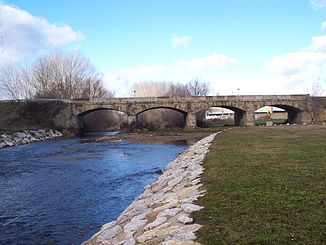Tuerto
| Rio Tuerto | ||
|
Rio Tuerto near San Justo de la Vega |
||
| Data | ||
| location |
Spain Castile and León |
|
| River system | Duero | |
| Drain over | Órbigo → Esla → Duero → Atlantic | |
| source |
Cantabrian Mountains 42 ° 25 ′ 26 ″ N , 6 ° 29 ′ 25 ″ W |
|
| Source height | approx. 1480 m | |
| muzzle |
Río Órbigo Coordinates: 42 ° 17 '28 " N , 5 ° 52' 54" W 42 ° 17 '28 " N , 5 ° 52' 54" W. |
|
| Mouth height | approx. 770 m | |
| Height difference | approx. 710 m | |
| Bottom slope | approx. 11 ‰ | |
| length | approx. 62 km | |
| Catchment area | 1443 km² | |
| Small towns | La Bañeza | |
| Communities | San Justo de la Vega | |
The Río Tuerto is an approximately 62 km long tributary of the Río Órbigo in the Spanish province of León in the autonomous region of Castile and León . It belongs to the river system (cuenca) of the Duero .
course
The Río Tuerto rises - depending on the rainfall at altitudes of approx. 1300 to 1500 m - in the area of the municipality of Villagatón on the south side of the Cantabrian Mountains and flows first in southern, later in southeastern directions; at the small town of La Bañeza it flows into the Río Órbigo .
Places on the river
Tributaries
- Río Porcos
- Río Turienzo
- Río Duerna
Reservoirs
- Embalse de Villameca
history
From Celts , Visigoths and Moors archaeological traces that are missing. At San Justo de la Vega, a place on the ancient Via de la Plata , an early Christian sarcophagus with scenes from the Old and New Testaments was found, which is now on display in the Archaeological Museum of Madrid .
Attractions
The upper course of the river in particular is scenic and popular with anglers; the communities and villages on its banks offer holiday apartments (casas rurales) for rent. Approx. 2.5 km east of Astorga , near San Justo de la Vega , the Way of St. James (Camino de Santiago) leads over the river.

